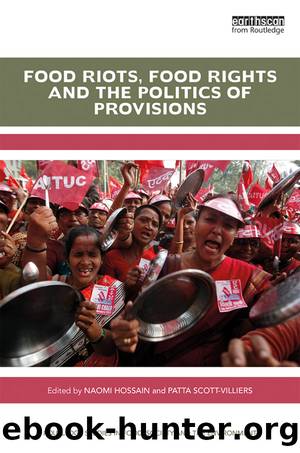Food Riots, Food Rights and the Politics of Provisions by Naomi Hossain Patta Scott-Villiers

Author:Naomi Hossain, Patta Scott-Villiers [Naomi Hossain, Patta Scott-Villiers]
Language: eng
Format: epub
Tags: Nonfiction, Social & Cultural Studies, Social Science, Sociology, Rural
ISBN: 9781351706179
Amazon: B0916K6M86
Goodreads: 57548481
Publisher: Taylor and Francis
Published: 2017-09-25T04:00:00+00:00
Southwest: Buea
Soppo/Buea
17
Muea
11
Ekona
6
Mile 4
13
Muyuka
Muyuka (formerly Soppo)
16
Mutengene
Mutengene
19
Mutengene 2
8
Limbe
Limbe
32
Likumba
12
Centre: Yaoundé
Mokolo
54
Mvog Mbi
37
Nkol Eton
19
Mvog-Betsi
25
Elig-Edjon
29
Essos
37
Biyem-Assi
11
Huitieme
25
The multi-focal approach was adopted to capture âsounds from the groundâ or impressions from people who may have been involved in the unrest, to learn more of the lived experience of the unrest and impacts on household food security. Interview questions ranged from questions about household size, employment and family assets to questions about household food shopping, what happens when food prices are high and what the households does when there is not enough money to buy food. Also included were questions about the foods that are commonly consumed when food prices are high and questions about the cheapest meal consumed in the household and the most favorite meal. Questions were also asked about what was remembered about the riots of 2008, what foods do you need to feel food secure and happy, and how has your diet changed over time. The quotations from individuals from the markets are not outliers but are representative of the theme under discussion. Accompanying the quotes from the surveys is the market name and the date the quotation was recorded. The author has not changed the quotes, relying on the informantsâ recorded account.
Table 5.2 characterizes the data by age, gender and reported class based on employment, income and assets. The data predominately represents middle class (65 per cent) females (86 per cent) between the ages of 20â40 (54 per cent). The data depicts a variety of occupations, primarily food vendors (~171) on precarious incomes in the informal sector. However, household interviews were also conducted with house cleaners (26), business owners and employees (17) teachers (18), civil servants (12), housewives (12), nurses (7), secretaries (7), students (8), lawyers (4), retirees (4), journalists (2), professors (2), aestheticians (2), hotel industry employees (2), a doctor, a naturopath, a landscaper, a builder, a prison guard, a taxi driver, an accountant, a freelance writer and a decorator. The participants represent a middle class in Cameroon from popular neighbourhoods, where contingent employment, employment in the informal sector, short-term employment as civil servants or seasonal workers on plantations are the norm (Bernards 2015; L. Sneyd 2015).
Table 5.2âCharacterization of interview data by age, gender, class
Download
This site does not store any files on its server. We only index and link to content provided by other sites. Please contact the content providers to delete copyright contents if any and email us, we'll remove relevant links or contents immediately.
Cecilia; Or, Memoirs of an Heiress — Volume 1 by Fanny Burney(32080)
Cecilia; Or, Memoirs of an Heiress — Volume 3 by Fanny Burney(31471)
Cecilia; Or, Memoirs of an Heiress — Volume 2 by Fanny Burney(31422)
The Great Music City by Andrea Baker(30801)
We're Going to Need More Wine by Gabrielle Union(18648)
All the Missing Girls by Megan Miranda(14805)
Pimp by Iceberg Slim(13808)
Bombshells: Glamour Girls of a Lifetime by Sullivan Steve(13706)
Fifty Shades Freed by E L James(12928)
Talking to Strangers by Malcolm Gladwell(12893)
Norse Mythology by Gaiman Neil(12866)
For the Love of Europe by Rick Steves(11580)
Crazy Rich Asians by Kevin Kwan(8903)
Mindhunter: Inside the FBI's Elite Serial Crime Unit by John E. Douglas & Mark Olshaker(8727)
The Lost Art of Listening by Michael P. Nichols(7172)
Enlightenment Now: The Case for Reason, Science, Humanism, and Progress by Steven Pinker(6884)
The Four Agreements by Don Miguel Ruiz(6330)
Bad Blood by John Carreyrou(6286)
Weapons of Math Destruction by Cathy O'Neil(5854)
